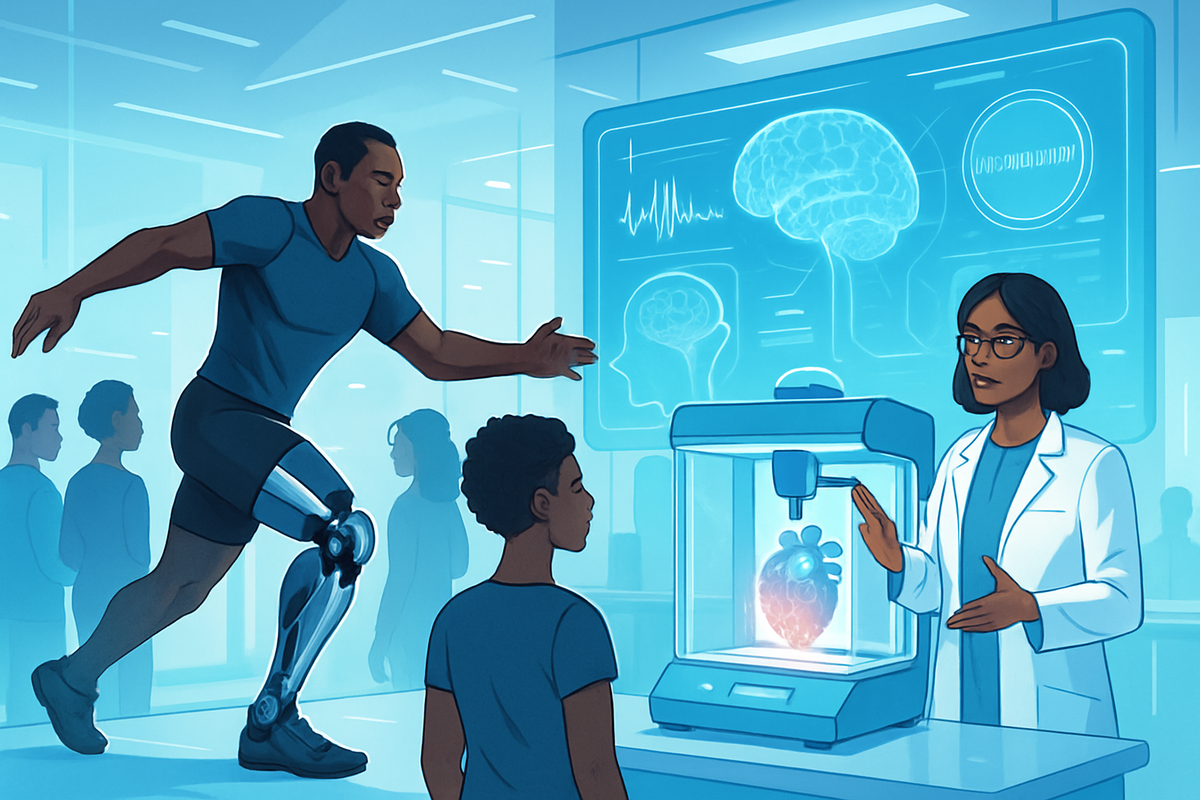The Rise of Next-Generation Bionics: How AI, Bioprinting, and Neural Interfaces Are Redefining Human Potential
Discover how AI, 3D bioprinting, and neural interfaces are transforming bionics, blurring the line between therapy and augmentation, and unlocking human potential like never before. Ready to embrace the bionic future? Dive in now!

Explore the dramatic convergence of artificial intelligence, 3D bioprinting, and neural interface technology in the bionics revolution. This feature demystifies how biohybrid implants and brain-machine interfaces are closing the gap between man and machine—unlocking new levels of mobility, sensory restoration, and even cognitive augmentation.
Welcome to the Bionic Boom: Why Now?
It’s 2025, and the age-old question—where does human end and machine begin?—is no longer just for science fiction fans or philosophers with impressive beards. Thanks to a wild convergence of AI, 3D bioprinting, and neural interfaces, the boundaries of human potential are being redrawn in real time. What was once reserved for cyborg heroes is now, quite literally, at our fingertips.
“We’re not just restoring lost function—we’re starting to enhance it. The line between therapy and augmentation is getting blurrier by the month.”
— Dr. Mira Esposito, neurotech researcher
How We Got Here: The Building Blocks of the Bionics Revolution
- AI-Driven Prosthetics: Modern bionic limbs now learn from their users, using embedded AI to adapt to walking styles, grip preferences, and even moods. Some can literally sense when you want to dance—or just need to scratch your nose.
- 3D Bioprinting: Gone are the days of one-size-fits-none. Advanced printers now layer living cells and smart materials, creating custom-fit organs and scaffolds that blend seamlessly with the body.
- Neural Interfaces: Tiny electrodes and wireless chips are bridging the gap between our nervous system and digital devices, making it possible to control prosthetics, computers, and even home appliances with a thought.
Real-World Stories: Bionics Beyond the Hype
Let’s break out of the lab and into real life. Meet some of the pioneers in this new era—not just the inventors, but the individuals living at the intersection of biology and technology:
A New Sense of Touch: The Bionic Hand You Can Feel
Earlier this year, a University of Chicago study demonstrated something extraordinary: test subjects with spinal cord injuries not only controlled a robotic hand via brain signals, but actually felt edges, shapes, and textures in real time. This wasn’t some vague buzz or tingle—it was the sensation of holding a steering wheel, or tracing a letter on a bionic fingertip. Welcome to the first wave of truly tactile prosthetics.
Biohybrid Organs: Printed, Personalized, and Practically Plug-and-Play
Imagine a world where the waitlist for a kidney transplant is replaced by a custom-printed, biocompatible organ—tailored from your own cells. While we’re not quite there yet, tissue-engineered and hybrid organs are in clinical trials, dramatically reducing rejection risks and promising decades of healthy function. (Yes, your next organ could be more ‘you’ than your current one!)
Brain-Machine Interfaces: Mind Over Matter
Neural interfaces aren’t just for controlling bionic limbs—they’re now helping restore speech, vision, and even memory. The latest brain-computer interfaces decode neural signals so precisely that some users can control a cursor, type, or interact with smart home devices simply by thinking about the action. (No more losing the remote—just think “volume up!”)
Inside the Tech: How AI, Bioprinting, and Neural Interfaces Integrate
- AI + Bioprinting: Machine learning algorithms optimize the layout of living cells, ensuring bioprinted tissues mimic native organs in both structure and function.
- Neural Interfaces + AI: Advanced signal processing cleans up brainwave data, allowing for real-time, intuitive control of prosthetics and smart devices.
- All Together Now: The next-gen bionic limb may use AI to interpret intent, a neural interface to relay commands, and bioprinted muscles for lifelike movement—all personalized for the user.
Industry Spotlights: Startups and Giants Reshaping the Field
- Touch Bionics: Pioneering customizable, multi-articulating bionic hands controlled by neural signals.
- Cochlear Ltd.: Leaders in smart auditory implants that stream directly from devices and adapt to your environment.
- Beta Bionics: Creators of the bionic pancreas—an AI-powered, closed-loop insulin delivery system.
- Medtronic & Boston Scientific: Driving the integration of remote monitoring, AI, and wireless connectivity in cardiac and neurostimulator implants.
The Ethical Frontier: Promise, Peril, and the Bionic Divide
Of course, with great power comes great... paperwork. (And philosophical dilemmas.) As bionics get smarter and more integrated, we face questions like:
- Who gets access? Will advanced bionics be available worldwide, or just to the privileged few?
- Where’s the line? At what point does restoring ability become enhancing it—and who decides?
- Data privacy: Your heart valve now streams data—who’s allowed to listen?
Regulatory bodies are racing to keep up, but the conversation is just beginning. Subscribe to join the discussion—only Funaix Insiders can comment on these hot topics!
The Road Ahead: What’s Next for Personalized Bionics?
- Biohybrid Implants: Combining living tissue with synthetic scaffolds for seamless integration and long-term function.
- AI-Enabled Self-Adjusting Devices: Your bionic limb will learn and adapt as you do—think of it as your own personal R2-D2, minus the beeps.
- Global Access Initiatives: Emerging markets in Asia-Pacific and Latin America are seeing rapid adoption, with local manufacturing and medical tourism making bionics more affordable.
- Regenerative Bionics: The fusion of stem cells, gene editing, and bionics could make full organ and limb regeneration a reality within a generation.
“The future of bionics is not just about replacing what’s lost—it’s about expanding what’s possible.”
— Dr. Anil Patel, biomedical engineer
Want to Shape the Future? Join the Conversation
From tactile bionic hands to AI-powered hearts, the next chapter in human evolution is being written now. Whether you’re a patient, clinician, engineer, or just a curious human, your voice matters. Subscribe for free at Funaix to unlock smart news, perks, and the ability to comment on articles. (Did we mention it’s free—for now?)
Let’s build the future of bionics—together.




